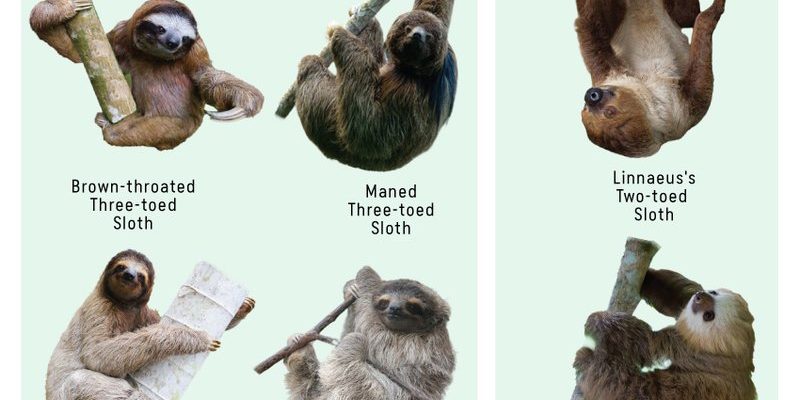![Comparing The Three-Toed Sloth Vs. [Similar Species]](https://gudri.com/wp-content/uploads/2025/06/Comparing_The_Three_Toed_Sloth_Vs___Similar_Species__image_0.jpg)
Both of these sloths have unique characteristics that set them apart, just as two siblings might have different hobbies or styles. For instance, the three-toed sloth has three long claws on each limb, while the two-toed sloth, as its name suggests, has two. Understanding these differences can help us appreciate their roles in their ecosystems and why they’ve evolved the way they have. So, grab a cup of coffee, sit back, and let’s explore the lazy life of these charming creatures.
Physical Differences Between Three-Toed and Two-Toed Sloths
First Impressions Count
When you first spot a sloth in the wild, their size and build might catch your attention. The three-toed sloth typically measures about 24 to 28 inches long and weighs between 15 to 20 pounds. Its body is more compact, and it has a distinctive, rounder face. On the flip side, the two-toed sloth can be a bit larger, reaching up to 29 inches long and weighing 8 to 17 pounds. Interestingly, this sloth has a more elongated face, giving it a unique charm.
Claws and Limbs: A Gripping Tale
One of the most noticeable differences is their claws. The three-toed sloth has three long claws on each limb, which are perfect for hanging onto tree branches. These claws are like natural hooks, allowing them to grip tightly as they navigate through the treetops. The two-toed sloth, however, has only two claws on each front limb. This difference can affect how they move; the two-toed version is generally more agile on the ground, although both sloths prefer the safety of the trees.
Habitat and Geographic Range
Where Do They Call Home?
Both sloths thrive in the lush *tropical rainforests* of Central and South America, but they prefer slightly different habitats. The three-toed sloth tends to stick to the *canopies* of rainforests, where it finds plenty of leaves to munch on. You might imagine it lounging high up, enjoying the view. In contrast, the two-toed sloth also enjoys trees but can be found at lower elevations. This adaptability allows it to thrive in a range of environments.
Climate Preferences
The humidity and temperature in these regions are crucial for both sloths. They rely heavily on the warmth of their surroundings to maintain their body heat, as they have a slower metabolism. You might be wondering how these differences affect their lifestyles. Well, the three-toed sloth might be more vulnerable to cold snaps since it prefers the elevated, warmer canopy. The two-toed sloth, being a bit more adaptable, can handle varying climatic conditions.
Diet: What Do These Sloths Eat?
Leafy Delights
Both the three-toed and two-toed sloths are herbivores, primarily munching on leaves. However, their diets do differ slightly due to their environments. The three-toed sloth often feasts on a variety of leaves, including those from the *almendro* tree. This sloth is picky, as some leaves can be toxic, requiring a selective approach.
Nutritional Strategies
The two-toed sloth, on the other hand, enjoys a more varied diet that includes flowers, fruits, and even the occasional insect. It’s kind of like when you’ve got a favorite dish but also enjoy trying new things. This varied diet helps the two-toed sloth get the nutrients it needs to sustain its energy levels.
Behavior and Activity Level
Are They Really That Slow?
Here’s the thing: both types of sloths are known for their leisurely pace. But there’s a catch! The three-toed sloth is typically even slower, spending the bulk of its day hanging around and snoozing. They can sleep up to 20 hours a day. Sounds like a dream, right? The two-toed sloth, while still slow, is a bit more active and may move around for food a few times a day.
Social Skills in the Sloth World
You might think sloths are loners, and while they do enjoy their personal space, they aren’t completely antisocial. Both species communicate through sounds, like soft grunts and bellows. However, the two-toed sloth is known for being more vocal, especially during mating season. Imagine a laid-back karaoke night in the treetops!
Reproduction and Lifespan
Cute Baby Sloths
When it comes to reproduction, sloths have a pretty straightforward process, but it varies slightly between species. The three-toed sloth generally gives birth to one offspring after a gestation period of around 11 months. These little ones cling tightly to their mothers for several months, learning the ropes of sloth life.
Age Matters
On average, both types of sloths live around 20 to 30 years in the wild. However, the two-toed sloth may have a slightly shorter lifespan due to its more adventurous nature and susceptibility to predators. So, while they both live long lives, the three-toed sloth could be considered the more cautious, safety-first sibling.
Conservation Status
Facing the Threats
Both the three-toed and two-toed sloths are experiencing threats due to habitat destruction and climate change. However, the three-toed sloth is currently classified as “Least Concern” by the IUCN, while certain populations of two-toed sloths are more vulnerable due to their limited range. It’s like comparing two friends, one who always stays close to home and another who travels a lot—one might face risks that the other doesn’t.
What You Can Do
If you’re passionate about helping sloths, consider supporting conservation organizations focused on preserving tropical habitats. Even small actions, like reducing plastic waste or spreading awareness about sloth conservation, can contribute to their future.
In the end, the three-toed sloth and the two-toed sloth showcase the beauty of nature’s diversity. Despite their differences, they both play essential roles in their ecosystems and remind us of the importance of protecting their habitats. It’s fascinating to learn how these two species adapt to their environments, their unique diets, and their lifestyles.
By appreciating these charming creatures, we also foster a sense of responsibility to ensure they continue to thrive in the wild. So next time you think of sloths, remember these lazy, lovable animals and the wonderful differences that make them so special.

